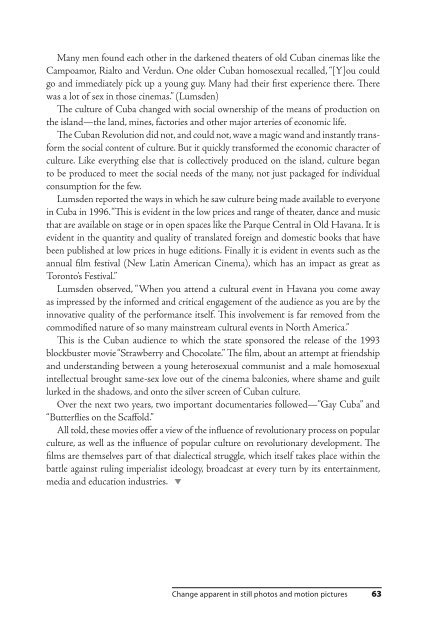LavenderRed_Cubabook
LavenderRed_Cubabook
LavenderRed_Cubabook
Create successful ePaper yourself
Turn your PDF publications into a flip-book with our unique Google optimized e-Paper software.
Many men found each other in the darkened theaters of old Cuban cinemas like the<br />
Campoamor, Rialto and Verdun. One older Cuban homosexual recalled, “[Y]ou could<br />
go and immediately pick up a young guy. Many had their first experience there. There<br />
was a lot of sex in those cinemas.” (Lumsden)<br />
The culture of Cuba changed with social ownership of the means of production on<br />
the island—the land, mines, factories and other major arteries of economic life.<br />
The Cuban Revolution did not, and could not, wave a magic wand and instantly transform<br />
the social content of culture. But it quickly transformed the economic character of<br />
culture. Like everything else that is collectively produced on the island, culture began<br />
to be produced to meet the social needs of the many, not just packaged for individual<br />
consumption for the few.<br />
Lumsden reported the ways in which he saw culture being made available to everyone<br />
in Cuba in 1996. “This is evident in the low prices and range of theater, dance and music<br />
that are available on stage or in open spaces like the Parque Central in Old Havana. It is<br />
evident in the quantity and quality of translated foreign and domestic books that have<br />
been published at low prices in huge editions. Finally it is evident in events such as the<br />
annual film festival (New Latin American Cinema), which has an impact as great as<br />
Toronto’s Festival.”<br />
Lumsden observed, “When you attend a cultural event in Havana you come away<br />
as impressed by the informed and critical engagement of the audience as you are by the<br />
innovative quality of the performance itself. This involvement is far removed from the<br />
commodified nature of so many mainstream cultural events in North America.”<br />
This is the Cuban audience to which the state sponsored the release of the 1993<br />
blockbuster movie “Strawberry and Chocolate.” The film, about an attempt at friendship<br />
and understanding between a young heterosexual communist and a male homosexual<br />
intellectual brought same-sex love out of the cinema balconies, where shame and guilt<br />
lurked in the shadows, and onto the silver screen of Cuban culture.<br />
Over the next two years, two important documentaries followed—”Gay Cuba” and<br />
“Butterflies on the Scaffold.”<br />
All told, these movies offer a view of the influence of revolutionary process on popular<br />
culture, as well as the influence of popular culture on revolutionary development. The<br />
films are themselves part of that dialectical struggle, which itself takes place within the<br />
battle against ruling imperialist ideology, broadcast at every turn by its entertainment,<br />
media and education industries. <br />
Change apparent in still photos and motion pictures 63


